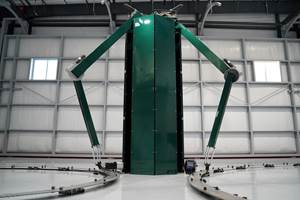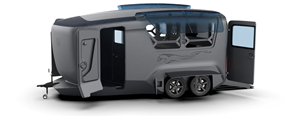Electron Beam Melting (EBM) Offers a New Alternative for Producing Titanium Parts and Prototypes
EBM promises to deliver fully dense parts with properties equal to wrought materials faster than other metal-based additive-fabrication methods.
Editor’s Note: When this article first appeared in 2006, Arcam was represented by Stratasys in the U.S. The former company has since been acquired by GE Additive.
Titanium offers a number of properties that are attractive to design engineers-high strength and low weight in addition to excellent corrosion and erosion resistance. Titanium is used in manufacturing anywhere strength and weight are an issue, such as automobile and plane parts. Completely inert to human body fluids, titanium is also ideal for medical replacement structures such as hip and knee implants. It is, however, difficult to machine, cast and weld.
Titanium Electron Beam Melting (EBM), patented by Arcam AB (Mölndal, Sweden) and distributed in the U.S. by Stratasys, Inc. (Eden Prairie, MN) offers a new method for rapid manufacturing and prototyping metal components-titanium in particular. The time, cost and challenges of machining or investment casting are eliminated, which makes titanium parts readily available for functional testing or installation. The additive process also opens the door to new design configurations and weight-reduction alternatives.
The EBM Process
In the Electron Beam Melting process, an electron beam is used to melt a titanium powder while the additive fabrication process builds parts on a layer-by-layer basis. After melting and solidifying one layer of titanium powder, the process is repeated for subsequent layers.
Within the electron beam gun, a tungsten filament incandesces and "boils off" a cloud of electrons which electrons stream through the gun at approximately half the speed of light. Two magnetic fields organize and direct the fast-moving electrons. The first field acts as a magnetic lens, which focuses the beam to the desired diameter. The second deflects the focused beam to the target point on the powder bed.
When the high-speed electrons strike the metal powder, the kinetic energy is instantly converted into thermal energy. When the temperature is above the melting point, the electron beam rapidly liquefies the titanium powder.
The electron beam gun is stationary and there are no moving mechanical parts for beam deflection. This delivers very high scanning speeds — up to 3,280 fps — and fast build rates — up to 60 cm3/hr (3.7 in.3/hr).
EBM occurs in a vacuum to prevent a loss of energy that would be caused by the fast-moving electrons colliding with air or gas molecules. The vacuum offers two advantages:
- EBM is 95 percent efficient in its use of energy — five to 10 times greater that laser technology
- The vacuum supports processing of reactive metal alloys like titanium.
Fully Dense Titanium
The EBM machine produces components from Ti6Al4V (titanium-6 percent-aluminum 4 percent Vanadium, or Ti64) and Ti6Al4V ELI, two "workhorse" alloys in manufacturing. The Ti64 parts exhibit properties that match those of wrought materials and exceed those of investment castings. The parts are 100 percent dense directly from the EBM machine, so there is no need for secondary infiltration processes. If desired, the Ti64 parts can be HIP (hot isostatic pressing) treated.
Parts produced with EBM are near-net shape like those made with metal casting processes. Since the electron beam fully melts the titanium, the liquefied metal conforms to the surrounding metal powder, which yields a surface finish similar to a precision sand casting. So, some light secondary machining or grinding may be required.
Opportunities Created
As with other additive fabrication processes, EBM has the ability to produce complex designs that are difficult or impossible to achieve when machining or casting. This freedom of design can be used to achieve true titanium parts that offer exceptional strength-to-weight ratios, decrease manufacturing costs and minimize assembly time.
Although titanium is often the best material for certain component applications, costs, challenges and time prevent its use. In these instances, machined or investment cast aluminum is used for weight reduction. When aluminum is not satisfactory, steel may be used in spite of its weight. With EBM, manufacturers have an effective alternative that combines the advantages of aluminum and steel while overcoming the obstacles of making titanium parts.
While this article has concentrated specifically on titanium, EBM has the versatility to process a wide range of metals. Arcam AB has chosen to concentrate on selected materials that most satisfy industry; however, research has been carried out on various metals. Materials such as stainless steels, aluminum, and copper alloys have been investigated and shown promise.
Another advantage is that the additive process can make a multi-piece assembly as one component. In those cases where the limits of machining and casting force a designer to create an assembly, EBM can reduce production costs. By combining two or more individual components into a single piece, assembly is eliminated, and the cost of manufacturing may be reduced. Costs are minimized using EBM through efficient recycling of the used powder. Very little powder is thrown away as waste and non-melted powder can be reused with no degradation in quality. This is good news for high-cost metal powders!
Aerospace companies, like Boeing Phantom Works, have recognized the benefits of EBM for prototyping and manufacturing. Replacing aluminum and steel parts with titanium and making a single part instead of an assembly have significant benefits to aerospace manufacturers. However, EBM offers an even greater benefit. It creates an opportunity to design and manufacture aircraft components with unprecedented strength-to-weight and buy-to-fly ratios. Besides making solid titanium parts, the additive EBM process can also produce hollow parts with an internal strengthening scaffold. Impossible with any other method, EBM can deliver the required mechanical strength with much less mass. This reduces the cost of raw materials and the weight of the component.
While the aerospace industry sees the potential of EBM, the overall build volume (200 x 200 x 180mm) limits the parts that can be manufactured. It may be impossible to please everyone but an increase in the build volume would significantly increase the use of EBM in the design of component parts.
Electron Beam Melting is a unique prototyping and manufacturing process that can simultaneously reduce costs, weight and time. It offers the material properties of machined titanium, expands the design complexity possible with casting and eliminates the challenges and time of both.
Related Content
Robot Vs. Gantry for Large-Format Additive Manufacturing (Includes Video)
Additive Engineering Solutions, specialist at 3D printing very large parts and tools on gantry machines, now also uses a robot for large-format AM. Here is how the robot compares.
Read MoreVideo: Construction 3D Printing with Robotics, Geopolymer
Alquist 3D is aiming to revolutionize construction and infrastructure with large-format robotic 3D printing using a carbon-neutral material.
Read More“Mantis” AM System for Spacecraft Uses Induction for Deposition
The metal 3D printing system melts wire without lasers. 30-foot-diameter parts are built on a rotary-feed system that eliminates the need for a large machine frame or gantry.
Read MoreNext-Gen Horse Trailers to Be Built With Robotic 3D Printing
Double D Trailers is currently developing a prototype horse trailer that will be made with large-format additive manufacturing. The technology brings potential benefits for labor, weight and design features to this subset of recreational vehicles.
Read MoreRead Next
Profilometry-Based Indentation Plastometry (PIP) as an Alternative to Standard Tensile Testing
UK-based Plastometrex offers a benchtop testing device utilizing PIP to quickly and easily analyze the yield strength, tensile strength and uniform elongation of samples and even printed parts. The solution is particularly useful for additive manufacturing.
Read MorePostprocessing Steps and Costs for Metal 3D Printing
When your metal part is done 3D printing, you just pull it out of the machine and start using it, right? Not exactly.
Read MoreAlquist 3D Looks Toward a Carbon-Sequestering Future with 3D Printed Infrastructure
The Colorado startup aims to reduce the carbon footprint of new buildings, homes and city infrastructure with robotic 3D printing and a specialized geopolymer material.
Read More




















